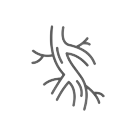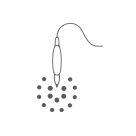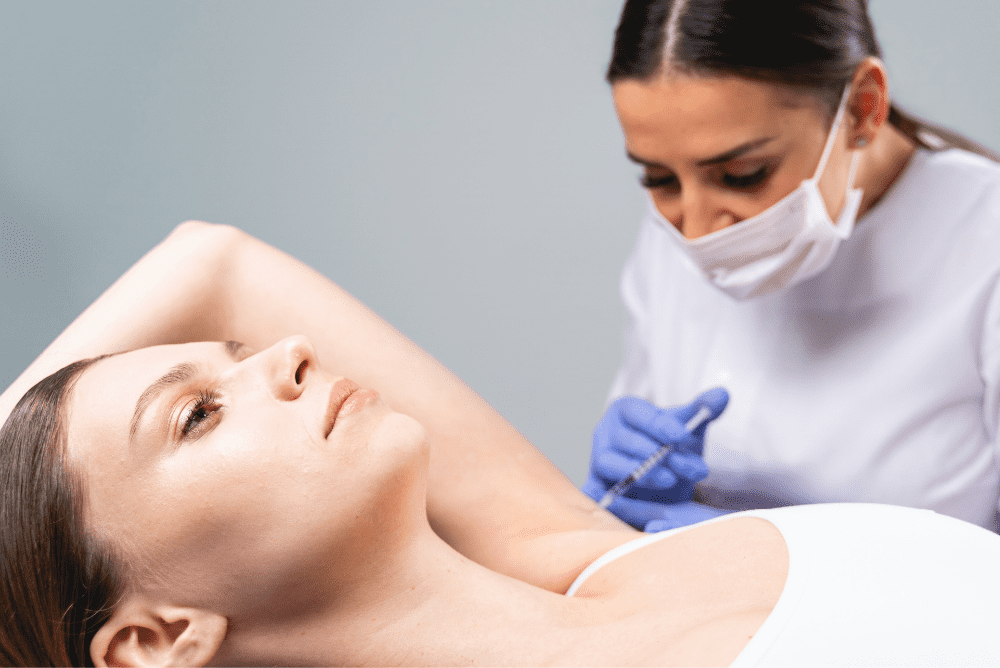Excessive Sweating
Excessive sweating is also know as hyperhidrosis and effects the underarms, feet or palms. It is a condition that causes the body’s sweat glands to overreact. A problem that effects the lives of many people. Thankfully, there is a solution that is offered by our Cosmetic Physician or our RNs. A confidential Clinic consultation will determine whether this treatment will help you.
Please contact the Clinic 780.929.9797 or beaumont@mdspa.ca for more information regarding this treatment option.

Our Treatments
While sometimes prescription antiperspirants, prescription creams or nerve blocking medications help with excessive sweating, Botox injection are also prescribed by doctors when medications fail to improve the quality of life. Botox is especially useful and the treatments are minimally painless when used to treat excessive armpit sweating.
Research indicates a high success rate, with one particular study revealing that 95% of participants with hyperhidrosis reported an impressive 83% decrease in sweat production just one week after receiving the treatment. Typically, the beneficial effects of this therapy persist for about 6 months, offering extended relief from symptoms.
Different Types of Antiperspirants for Excessive Sweating
Over-the-Counter Antiperspirants:
The first line of defense for many are over-the-counter (OTC) antiperspirants. These products contain aluminum-based compounds, such as aluminum chloride, which temporarily block the sweat ducts, thereby reducing the amount of perspiration that reaches the skin’s surface. OTC antiperspirants come in various strengths and forms, including roll-ons, sprays, and sticks, offering a convenient and immediate solution for mild to moderate sweating.
Prescription-Strength Antiperspirants:
For those who find regular OTC antiperspirants ineffective, prescription-strength options may be necessary. These contain a higher concentration of aluminum chloride and are designed for individuals with severe hyperhidrosis. While more potent, they may also increase the risk of skin irritation, so it’s crucial to use them under the guidance of a healthcare professional.
Clinical-Strength Antiperspirants:
A middle ground between OTC and prescription antiperspirants, clinical-strength versions provide a higher level of protection without the need for a prescription. They are formulated to offer extended protection against sweating, making them suitable for those with an active lifestyle or those who experience stress-induced perspiration.
Natural and Aluminum-Free Antiperspirants:
In recent years, there has been a growing demand for natural and aluminum-free options due to concerns about the long-term effects of aluminum on health. These products use ingredients like natural mineral salts and other alternatives to block sweat. While they are generally safer and less irritating to the skin, they may not be as effective for individuals with severe hyperhidrosis.
When choosing an antiperspirant, it’s essential to consider factors like the severity of your sweating, skin sensitivity, and personal preferences. Some may prefer the feel of a gel, while others might find a spray more convenient. It’s also important to note that while antiperspirants can significantly reduce sweating, they do not cure hyperhidrosis and will need to be applied regularly.
Iontophoresis Treatment for Excessive Sweating
Iontophoresis is a non-invasive treatment method commonly used to manage excessive sweating, medically known as hyperhidrosis, particularly in the hands and feet. This technique utilizes a device that delivers mild electrical currents while the affected areas are submerged in water. The process temporarily disables the sweat glands, providing relief from excessive sweating. Patients typically undergo sessions ranging from 20 to 30 minutes each, several times a week initially. Once the desired level of dryness is achieved, the treatment frequency can be reduced to maintain results.
Iontophoresis is particularly favored for its safety and efficacy, with many patients experiencing substantial improvements after a few sessions. It’s a suitable option for those who have not responded well to antiperspirants or who prefer a non-invasive, drug-free approach. The side effects are typically minimal and may include mild skin irritation or a temporary discomfort during treatment. However, it’s not recommended for pregnant women, people with pacemakers or metal implants, or those with skin issues like infections or open wounds in the treatment area.
Botulinum toxin Treatment for Excessive Sweating
Botulinum toxin, widely known as Botox, is a highly effective treatment utilized in the clinical management of hyperhidrosis, or excessive sweating, particularly in areas such as the underarms, hands, feet, and face. This neurotoxic protein works by temporarily blocking the chemical signals from the nerves that stimulate sweat glands, thereby reducing sweat production in the treated area. During the procedure, a medical professional carefully injects small quantities of Botox into the targeted sweat-prone zones using a fine needle. This process typically involves multiple injections to ensure the area is adequately covered, and while it may cause some discomfort, it is generally well-tolerated with the use of topical anesthetics or ice to minimize pain.
The effects of Botox are not immediate; it usually takes about 2 to 4 days to start noticing a reduction in sweating, with full results typically observed within 2 weeks. The efficacy of Botox for hyperhidrosis is well-documented, with many patients experiencing a significant decrease in sweating for about 4 to 6 months. After this period, the treatment’s effects gradually diminish, and repeat injections are required to maintain dryness.
Botox is particularly favored for its targeted approach and high success rate. It’s an excellent option for patients seeking a non-surgical solution with minimal downtime. Most individuals can resume their regular activities immediately after the procedure, making it a convenient option for those with busy lifestyles. Side effects are usually minor and temporary, including potential bruising, soreness, or localized weakness. It’s crucial for the treatment to be performed by an experienced medical professional to ensure precision and minimize risks.
In summary, Botox injections offer a safe, effective, and minimally invasive option for individuals struggling with excessive sweating. This treatment can markedly improve the quality of life for patients, providing relief and increased comfort in social and professional settings. As with any medical treatment, a thorough consultation with a healthcare provider is essential to assess suitability, discuss potential risks, and ensure the best possible outcome.













